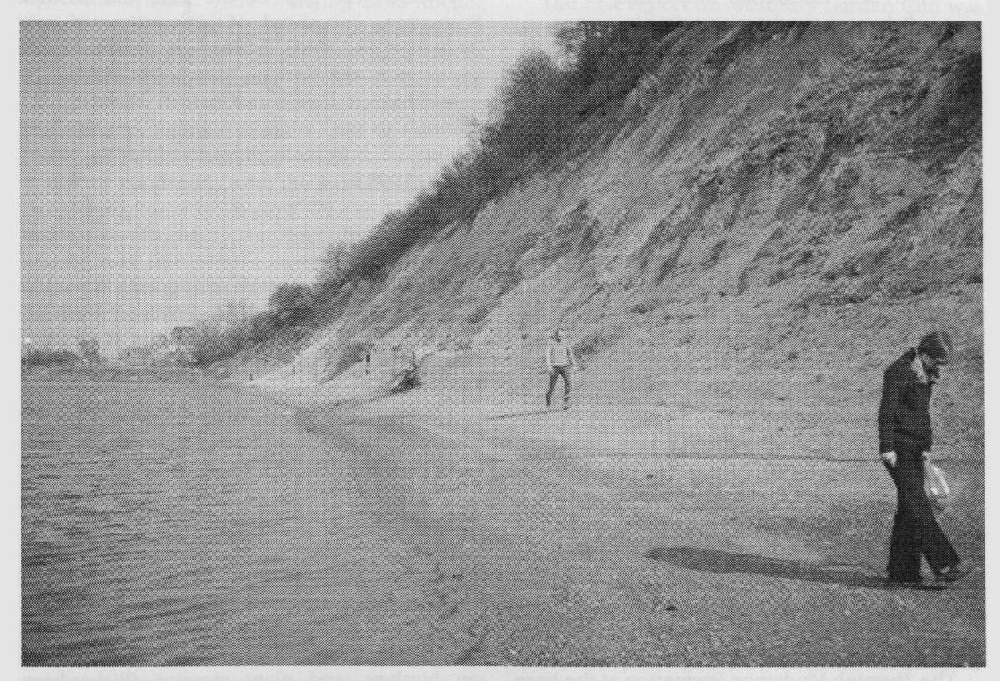Wainlode Cliff, Gloucestershire
Introduction
Wainlode Cliff exposes a good section through uppermost Triassic rocks, and is an important fossil locality. The rocks exposed include the
The Wainlode Cliff section has been investigated by geologists since at least the early years of the 19th century. References include Strickland (1841), Brodie (1845, 1858), Wright (1860), Etheridge (1865), Richardson (1903a,b, 1947), Reynolds and Vaughan (1904), and Sykes (1977).
Description
The Wainlode Cliff section is on the east bank of the River Severn, near the village of Norton, between Tewkesbury and Gloucester. The section is good, although the beds towards the top of the cliff are virtually inaccessible (Swift, 1995).
Sedimentology
Wainlode Cliff exposes a sequence of Upper Triassic sediments, including the Twyning Mudstone and Blue Anchor formations of the
| Thickness (m) | |
| Lias | |
| Hard blue limestone | 0.10 |
| Shales, brown and grey, finely laminated, with a discontinuous limestone at the base | 0.38 |
| 'Insect Limestone': hard, dark grey and blue | 0.13 |
| Shales, blue and brown, laminated, weathering to marly clay | 1.57 |
| 'Euestheria Bed': hard, yellow, nodular limestone, dendritic markings, irregular fracture | 0.15 |
| Shales, pale greenish-yellow, coarsely laminated, marly | 1.83 |
| Shales and limestone: | |
| (a) Shales, black, coarsely laminated, slightly calcareous | 0.91 |
| (b) Limestone, very hard, grey, slightly pyritic; an irregular but continuous band | 0.03 |
| Shales, black, imperfectly laminated | 0.25 |
| Pecten limestone, grey to black, with fibrous layers of limestone, shelly | 0.025 |
| Shale, black and fissile, with bivalves | 1.5 |
| Sandstone, discontinuous, pyritic | 0.03 |
| Shales, black, clayey, laminated | 0.15 |
| Sandstone, micaceous, pyritic, in one or two seams | 0.03 |
| Shales, black, firm, coarsely laminated | 0.30 |
| Interbedded sandstone and clay: | |
| (a) sandstone, hard, calcareous, micaceous, pyritic | 0.03 |
| (b) clayey parting, selenitic, variable | 0.03 |
| (c) sandstone, hard, calcareous, micaceous, pyritic | 0.01 |
| Shale, black and fissile, with some thin, calcareous siltstone lenses that have sporadic minute fossils | 0.35 |
| Sandstone and siltstone, calcareous, divided into six units: | 0.17 |
| (a) black shales with thin calcareous sandstone | |
| (b) fine, calcareous, pyritic sandstone with some medium sandstone concentrations associated with bony fossils | |
| (c) fine, calcareous, sandstone and siltstone with scattered fine bone remains | |
| (d) fine, calcareous, micaceous, light-grey sandstone, pyritic in part | |
| (e) fine, calcareous, light grey sandstone with much pyrite. Some small vertebrate fossils and occasional larger specimens and coprolites | |
| (f) light grey silt, calcareous, micaceous and unfossiliferous | |
| Shale, black and fissile, with occasional silts | 0.5 |
| Mudstone, black, poorly bedded, with some clay and some silt layers | 0.1 |
| Slue Anchor Formation ('Upper Keuper' of Richardson, 1903a): | |
| Light greenish-grey marls, weathering bluish-grey. Conspicuous green layer at the top | 7.00 |
| Twyning Mudstone Formation (former 'undifferentiated red mudstone') | |
| Red mudstones; variegated red marls, with zones of grey and greenish-grey marl; angular and conchiodal fractures | 22.86 |
The Twyning Mudstone Formation at the base of the cliff comprises mainly red clays and marls, with patches of grey, green, and blue sediment. Gypsum is occasionally present in these beds (Richardson, 1903a). Overlying these red beds are the paler greenish-grey, fine-grained sediments of the
Most of the
Towards the top of the cliff, the
Palaeontology
Many of the horizons in the
The record of Euestheria minuta var. brodieana is historically important, since the taxon was named in the first report of this characteristic Rhaetian fossil from the
Interpretation
As with all late Triassic exposures in south-west Britain, the section at Wainlode Cliff shows the palaeoenvironmental change from terrestrial to marine conditions associated with the Late Triassic marine transgression. The oldest beds, the Twyning Mudstone Formation, record a dominantly terrestrial environment characterized by low-lying, supratidal plains with shallow hypersaline lakes. The overlying
The
sion. Succeeding beds in the WestburyFormation are characteristic of low-energy conditions, probably associated with shallow seas. The overlying
Conclusions
Wainlode Cliff exposes a sequence of sedimentary rocks that range in age from Late Triassic to Early Jurassic. The sediments record a change in environmental conditions from terrestrial with hypersaline lakes (the
through marine transgressive and shallow marine (

